Association between four anthropometric indices with age-related Macular Degeneration from NHANES 2005-2008
- PMID: 39799346
- PMCID: PMC11724460
- DOI: 10.1186/s12944-024-02424-2
Association between four anthropometric indices with age-related Macular Degeneration from NHANES 2005-2008
Abstract
Background: Age-related macular degeneration (AMD) decrease vision and presents considerable challenges for both public health and clinical management strategies. Obesity is usually implicated with increased AMD, and body mass index (BMI) does not reflect body fat distribution. An array of studies has indicated a robust relationship between body fat distribution and obesity. This research is to evaluate the relationship between anthropometric measurements and AMD in the United States citizens in a cohort of patients.
Methods: Our study included a cohort of 3,127 participants, all of whom were selected from the National Health and Nutrition Examination Survey (NHANES) conducted between 2005 and 2008. Various anthropometric indices, including weight (WT), waist circumference (WC), Body Mass Index (BMI), waist-to-height ratio (WtHR), circularity index (CI), weight-adjusted waist circumference index (WWI), body roundness index (BRI), a body size index (ABSI), and visceral adiposity index (VAI), have been studied extensively within public health and nutrition to assess body fat distribution. Odds ratios (OR) for each anthropometric index, in relation to AMD and its different stages, were computed, adjusting for confounding variables. Smoothed curve fitting, coupled with weighted multivariable logistic regression analysis, was used to examine the impact of these anthropometric measures on the prevalence of AMD. Subgroup analyses were conducted according to gender, age, BMI, drinking, smoking, CVD, diabetes, hypertension, cataract operation, and glaucoma.
Results: After adjusting for all variables, significant positive correlations were observed between WtHR (OR = 1.237 (1.065-1.438)), BRI (OR = 1.221 (1.058-1.410)), CI (OR = 1.189 (1.039-1.362)), and WWI (OR = 1.250 (1.095-1.425)) with AMD, particularly for early AMD. However, no significant effects of these indicators were observed in late AMD. CI exhibited a positive linear relationship with AMD. Two-segment linear regression modeling revealed positive nonlinear associations between WtHR, BRI, and WWI with AMD. The positive association was more pronounced with excessive alcohol consumption for WtHR, BRI, CI, and WWI (P for interaction = 0.0033, 0.0021, 0.0194, and 0.0022, respectively). Additionally, WWI and CI exhibited stronger associations with AMD in females (P for interaction = 0.0146 and 0.0117, respectively). Furthermore, WtHR was associated with AMD in non-smokers (P for interaction = 0.0402).
Conclusion: This study confirmed a increased risk between four anthropometric measures, including WtHR, BRI, CI, and WWI, with AMD, especially early AMD. The findings suggest that these four anthropometric indices should be more broadly utilized to improve early AMD prevention and treatment strategies. Additionally, we found that the positive association between these four body measurement indices and AMD was more pronounced in individuals with high alcohol consumption.
Keywords: Age-related macular degeneration; Anthropometric indicators; National health and nutrition examination survey.
© 2024. The Author(s).
Conflict of interest statement
Declarations. Ethics approval and consent to participate: This investigation was approved by the National Center for Health Statistics. Ethics Review Board. Informed consent was obtained from all subjects involved in the NHANES. Consent for publication: Not applicable. Competing interests: The authors declare no competing interests.
Figures
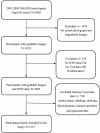
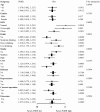
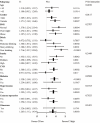
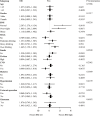
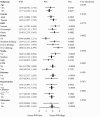

Similar articles
-
Predictive value of six anthropometric indicators for prevalence and mortality of obstructive sleep apnoea asthma and COPD using NHANES data.Sci Rep. 2025 May 9;15(1):16190. doi: 10.1038/s41598-025-99490-y. Sci Rep. 2025. PMID: 40346342 Free PMC article.
-
Novel anthropometric measures are positively associated with erectile dysfunction: a cross-sectional study.Int Urol Nephrol. 2024 Mar;56(3):855-865. doi: 10.1007/s11255-023-03840-6. Epub 2023 Oct 16. Int Urol Nephrol. 2024. PMID: 37843775
-
Associations between eight anthropometric indices and Parkinson's disease: a nationwide population-based study.Front Nutr. 2025 Jun 27;12:1621658. doi: 10.3389/fnut.2025.1621658. eCollection 2025. Front Nutr. 2025. PMID: 40655479 Free PMC article.
-
Association of body roundness index with cardiovascular disease in patients with cardiometabolic syndrome: a cross-sectional study based on NHANES 2009-2018.Front Endocrinol (Lausanne). 2025 Feb 3;16:1524352. doi: 10.3389/fendo.2025.1524352. eCollection 2025. Front Endocrinol (Lausanne). 2025. PMID: 39963283 Free PMC article. Review.
-
Obesity and cancer: An update of the global impact.Cancer Epidemiol. 2016 Apr;41:8-15. doi: 10.1016/j.canep.2016.01.003. Epub 2016 Jan 14. Cancer Epidemiol. 2016. PMID: 26775081 Review.
References
-
- Guymer RH, Campbell TG. Age-related macular degeneration. Lancet (London England). 2023;401(10386):1459–72. 10.1016/s0140-6736(22)02609-5. PubMed PMID: 36996856; eng. - PubMed
-
- Wong WL, Su X, Li X, et al. Global prevalence of age-related macular degeneration and disease burden projection for 2020 and 2040: a systematic review and meta-analysis. Lancet Global Health. 2014;2(2):e106–16. 10.1016/s2214-109x(13)70145-1. PubMed PMID: 25104651; eng. - PubMed
-
- Zhang Q-Y, Tie L-J, Wu S-S, et al. Overweight, obesity, and risk of age-related Macular Degeneration. Invest Opthalmology Visual Sci. 2016;57(3). 10.1167/iovs.15-18637. - PubMed
MeSH terms
LinkOut - more resources
Full Text Sources
Medical

